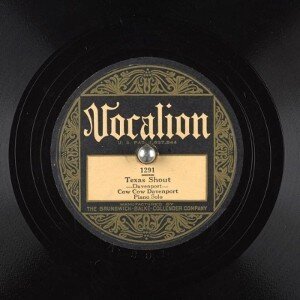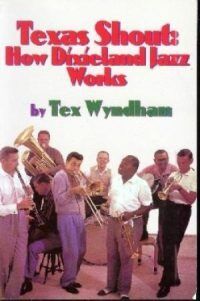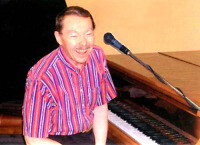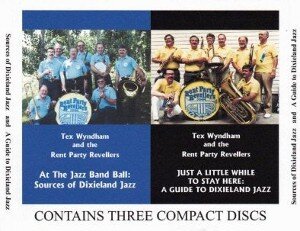 Set forth below is the fifty-third “Texas Shout” column. The initial installment of a two-part essay, it first appeared in the August 1994 issue of the West Coast Rag, now known as The Syncopated Times. The text has not been updated.
Set forth below is the fifty-third “Texas Shout” column. The initial installment of a two-part essay, it first appeared in the August 1994 issue of the West Coast Rag, now known as The Syncopated Times. The text has not been updated.
Any musical group requires a system to tell its members two things at each step of every performance: (1) which strain, theme or portion of the composition is to be played and (2) which instrumentalists are supposed to be playing it. In Dixieland bands, the members refer to that system as the “routine” or, less frequently, the “road map.”
(It is also sometimes referred to as the “chart” or “arrangement.” However, for purposes of today’s column, I will use those terms only when referring to a score that has at least all of its ensembles, and maybe the solos as well, completely written out or otherwise preplanned note for note.)
Combos develop routines in a number of ways. Some, of course, use written arrangements, so that the instrumentalist just has to be able, as Jelly Roll put it, to “read those little black dots.”
Many Chicago-styled bands, which are primarily solo-oriented, are less concerned about the intricacies of routines than they are about quickly getting to the solo parts of the rides. Many of them do quite well with only a single basic routine, one that specifies the solo order. An example might be: opening ensemble, solos by clarinet, trumpet, trombone and piano; closing ensemble.
Other combos may not want to write out charts, but still wish to present their audiences with more variety in routines. They might have separate road maps for each tune.
To illustrate, whenever such a unit plays Tune X, its routine will be: ensemble chorus, piano solo, ensemble verse, trumpet half-chorus solo, trombone half-chorus solo, clarinet-banjo full-chorus duet (other rhythm instruments out), ensemble chorus. Tune Y will also have a set routine but a different one, Tune Z different yet, etc.
If you don’t want to plan your routines in advance then you need a code to designate on the spot who’s supposed to do what. The most common of these has the on-stage leader pointing to the next soloist when it’s his turn. This is the method used by almost all pickup or jam bands.

These spontaneous systems are often fine-tuned by adoption of a mutually understood set of hand and/or verbal signals that the leader can use to introduce various devices into the rides. These effects might include a key change, a move to a different strain, or musicians coming in and out of the action.
All of these ways of operating are “right” ways. Many first-rate combos can be found using each of them.
Despite what some devotees of various Dixieland styles will tell you, there is no one best way to set routines for your band. Whichever one you adopt will be fine, as long as your group always tries to produce jazz that strives to be hot, swinging and inventive.
I’ve said many times in this column that improvisation is not necessary to good jazz. There have been, and will continue to be, many worthwhile jazz performances in which every note has been specified in advance.
However, I doubt that you will ever find me interested in participating in any of them. I get my biggest jazz kicks from being part of a group that has, to the maximum extent possible, the freedom to take the ride where, at that unique point in time, it wants to go.
Lots of musicians respond to a well-wrought arrangement, are able to play it over and over with the proper feelings of spontaneity and swing, and gain satisfaction each time they do so. I respect such views, but I’m not turned on by them. If we all know in advance what we’re supposed to play, I’d just as soon skip that tune and go on to something else.
I feel much the same way with set-piece routines. Even if the notes aren’t specified, I would eventually become bored playing in a band where, for example, in every rendition of “Papa Dip,” the clarinet played the first half of the third chorus and I played the second half. The clarinetist may be the greatest stickman in the world, but I’d soon start to wonder what I might come up with if the preceding soloist, once in a while, played a different instrument, or if I played the first half of the chorus occasionally, or if everybody dropped out on my solo except the bass or . . . you get the picture.
These feelings crystallized when I came to realize that Dixieland is the branch of jazz in which the largest number of musicians can function effectively on stage without any type of arrangement. A seasoned Dixielander learns to assimilate the output of as many as seven other improvising musicians and to instantaneously improvise a line that will enhance and compliment their efforts. By contrast, more advanced forms of jazz use such complex lines and dense chords that, without a chart, things start to get noisy above five or six sidemen.
After extended experience in combos from duets to octets that have varying kinds of instrumental makeup, a skilled Dixielander will enlarge that special talent. He/she will develop an instinct for performing in a way that turns the group in which he/she is functioning at the moment into a fully realized unit, one that sounds complete with whatever instrumentation is being heard.
I like to be in bands that get the participants to use that enlarged ability as much as possible. In such combos, any musician might suddenly find himself playing either entirely alone or with any combination of the others, being forced into a new “ensemble,” a new context in which he/she must, together with whoever else is playing at the time, create something that will be meaningful and still keep the ride developing in larger terms.
Decades ago, I began operating along those lines with my Wilmington, Delaware-based Red Lion Jazz Band. It turned out that verbal signals worked fine with the Red Lions because we jammed together every week at my home. Thus, we got to know each other’s styles intimately. The sidemen became used to listening to my verbal cues and executing them cleanly on the spot.
I tried the same verbal signals with The Rent Party Revellers, but ran into trouble doing so. The Revellers are a bigger band (octet vs. septet), and have a more aggressive approach to Dixieland. It was hard for me to be heard on stage.
To compound the problem, the Revellers are a “reunion” band that only comes together a few times a year. The sidemen were not as used to my methods as the Red Lions, so I had to work harder to be sure everyone was picking up the signals.
Things came to a head the first time we played a week-long festival, at St. Louis in 1985. Halfway through the week I was starting to lose my voice from shouting vocal cues during the sets.
Our pianist, Dick Shooshan, came to my rescue by presenting the Revellers with a set of hand signals. Maybe he invented them on the spot, maybe he’d been using them for years with the Golden Eagles, but in any event they were what we needed.
I’ve used them ever since, adding a few new ones of my own, and even stealing a few others (e.g., a hand signal, to cue rhythmic afterbeats, I picked up while subbing with The Buck Creek Jazz Band). I still use voiced signals for some things, but not so much, and I don’t get hoarse anymore.
Part 2: Texas Shout #54 Jazz Band Hand Signals
 Want to read ahead? Buy the book!
Want to read ahead? Buy the book!
The full run of “Texas Shout” has been collected into a lavishly illustrated trade paperback entitled Texas Shout: How Dixieland Jazz Works. This book is available @ $20.00 plus $2.95 shipping from Tex Wyndham, On request, Tex will autograph the book and add a personalized note (be sure to tell him to whom the note should be addressed).
Tex Wyndham’s 3 CD Guide to Dixieland with music and commentary is available for $20 plus $2.95 shipping. The separate CD, A History of Ragtime: Tex Wyndham Live At Santa Rosa, is available for $13.00 plus $2.00 shipping. On request, Tex will autograph the inner sleeve and add a personalized note (be sure to tell him to whom the note should be addressed).
Send payment to Tex Wyndham, P.O. Box 831, Mendenhall, PA 19357, Phone (610) 388-6330.
Note: All links, pictures, videos or graphics accompanying the Shouts were added at the discretion of the Syncopated Times editorial staff. They did not accompany the original columns and do not necessarily reflect the opinion of Tex Wyndham.
From roughly 1970-2010, Tex Wyndham was: (1) one of the best-known revivalist Dixieland jazz musicians in the US, as cornetist, pianist and bandleader, (2) one of the best-known ragtime pianists in the US, and (3) one of the most respected critics in the US of Dixieland jazz, ragtime, and related music. He is the only person about whom all three of those statements can be made.




